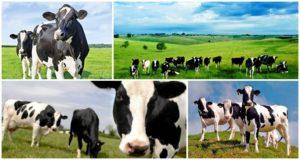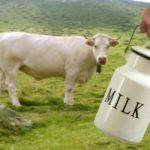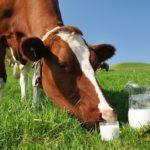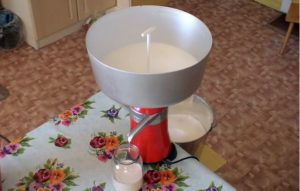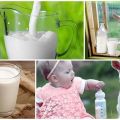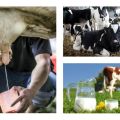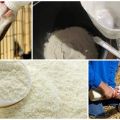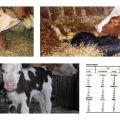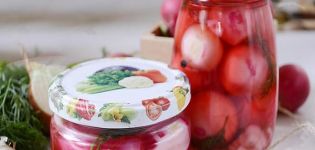At what age does a cow begin to milk and how it is produced
The cow is only able to give milk after calving. This animal is not a dairy machine. Certain physiological processes take place in the body of cattle, milk appears when you need to feed the calf. The stomach of a newborn is not able to digest plant foods. Such an opportunity occurs in an animal at 3-4 months of age. The man took advantage of this feature and began to select milk intended for calves.
When does a cow start giving milk?
A cow's milk appears immediately after giving birth, but not earlier, since the female does not milk without a calf. Sexual maturity in animals occurs at 8-10 months. True, females are ready for mating (insemination) only in the second year of life. The body weight of heifers at this age should be at least 330 kg.
Pregnancy (pregnancy) in females lasts 9 months. Immediately after coating, the body of a young heifer undergoes changes, the mammary glands prepare for milk production. If a dairy cow is pregnant, then after insemination it is milked as usual, and two months before giving birth, it is started, that is, transferred to dead wood and milking is stopped.
The lactation period in animals lasts 12-14 months. It is continually extended by the next calving. Cows are usually fertilized two months after the calf is born. Without giving birth, that is, without calving, the cow does not give milk. Lactation occurs only after the birth of the calf. It can last for 5 years, but females are inseminated every year. The more often a cow gives birth, the more milk she gives. The peak of productivity comes after the birth of the fifth calf.
Another nuance - the older the cow, the more milk she gives. Young animals are not as productive. They give only 10-12 liters of milk per day, and a cow over 5 years old - 20-30 liters of milk per day.

Where does it come from?
The cow is a ruminant that feeds on grass and hay. The food enters the rumen, then regurgitates, chews again and returns to the anterior sections and to the stomach itself. Cattle eat 7-8 hours a day, and the same amount of time is spent on chewing food. Through the walls of the stomach and intestines, the released nutrients enter the bloodstream.
During the digestion of feed, a large amount of gas is released, which the cow regurgitates. Nutrients entering the bloodstream are carried throughout the cattle body.They are used as energy and building material, as well as for milk production. True, lactation in an animal for the first time begins only after the birth of a calf.
Milk is produced by the epithelial cells of the alveoli, which are located in the udder. It is taken, or rather, it is formed from nutrients that enter the mammary glands from the blood. For milk production, common proteins, fats and carbohydrates are used. The composition of this product depends on the diet of the animal. It is removed from the udder due to the milk flow reflex. With a slight irritation of the nerve endings in the walls of the nipples, a stream of nerve impulses rushes into the brain and hypothalamus, as a result of which the hormone oxytocin is released. With the blood stream, it enters the mammary gland and causes a contraction of myoepithelial cells.
The resulting milk enters the cavity of the alveoli, ducts and udder cisterns. If the udder is full, the secretory functions are suspended. Although milk can be produced continuously, the secretion process begins immediately after milking the cow. This is why it is so important to milk the animal to the end. When the tanks are emptied, a signal is given to produce a new portion of milk. In stressful situations, on the contrary, the hormone adrenaline is formed, which leads to compression of the muscles of the milk ducts and inhibits the milk flow reflex. It is undesirable to frighten cattle before milking, otherwise it will not give milk.
How to help the product appear
Milk, or rather, colostrum first, appears in cattle after calving. It is recommended that the animal be milked immediately after giving birth, completely emptying the udder tanks to stimulate the production of a new portion of the product.
The amount of milk is influenced by feed, its quality and quantity, as well as regular milking (3 times a day at the same time).
Grass, hay, haylage and silage form the basis of the cows ration. Bulky feed is needed for the well-coordinated work of the digestive system of cattle. The amount of milk production depends on their number. Root crops have a milk-producing effect. It is for this reason that farmers try to feed cows with fodder beet tops and grated vegetables. On the contrary, cereal mixtures decrease milk yield, but increase the weight of animals.

In order for a cow to regularly give a lot of milk, she must have a good appetite. Yeast probiotics help improve this indicator. The cow should be full of food, that is, eat at least 50 kg of grass per day. In semi-starved animals, milk yields are usually low. Milk production is affected by water. Cattle should drink 30-40 liters of liquid twice a day. Lactation in a cow lasts a long time, almost a year. It is extended after the next calving.
What affects milk quality?
The quality of milk produced in the mammary glands is influenced by several factors: feed, cattle care, cow health. It is recommended that the animals graze on pasture during the warm season.
During grazing, cows receive complete proteins, carbohydrates, vitamins and microelements. Desirable vegetation - legumes and grasses 15 cm high.
During the grazing period, animal health improves, productivity increases. True, during grazing, you need to make sure that the cow does not eat wild radish, buttercups, rapeseed, rape, field mustard. These herbs give a bitter taste to dairy products. Vegetables such as turnips, rutabagas, turnips, garlic, onions, fennel, and cabbage degrade the quality of milk. The presence of peppermint in the diet can color dairy products bluish, and ivan-da-marya or mariannik will give a bluish tint. Eating zhiryanka, cattle gives sticky milk.
The feeds that are fed to animals all year round affect the quality indicators of dairy products.If cattle are given too much oil cake, then the butter turns out to be soft and quickly spoiling, and the milk is not suitable for making cheeses (it does not coagulate well under the influence of rennet). For the same reason, it is not recommended to graze animals in swampy areas.
A soft butter is obtained when animals graze in a meadow, while hay and grain, on the contrary, give this product a firmness. As for the keeping of cattle, if the cows are milked in a dirty barn, then the milk picks up the smell of manure.
Can a cow give milk without calving?
A cow is an animal that produces milk in order to feed calves born into the world. Cubs feed on this product for up to 3-4 months. Immediately after the birth of the calves, the female is milked several times a day, which makes the body think that the newborn is constantly short of milk. Thanks to regular milking, the udder tanks are filled.
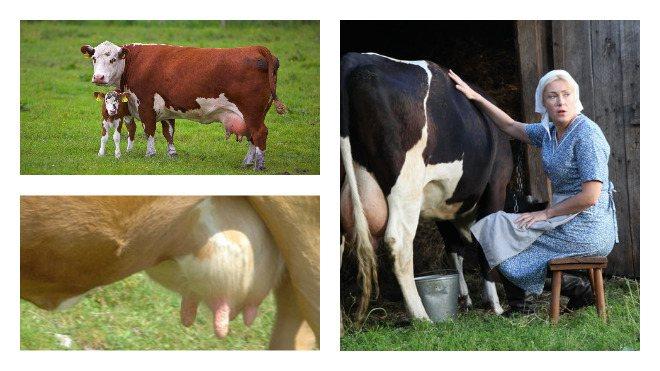
If cattle are not milked for several days, then milk will disappear until the next calving. In order for the female to constantly milk, she must give birth annually. There is no milk without the birth of a calf. A cow incapable of pregnancy is called a barn cow. Such an animal is sent to the slaughter for meat.
Problems of low milk production and milklessness
A few days after the birth of the calf, the cow produces the largest amount of milk. After 6 months, productivity begins to drop sharply, and after 300 days, lactation may stop. To increase the milk production, it is recommended to inseminate the female again two months after calving.
True, she will begin to give more milk only after childbirth. The cow should be milked regularly, without interruption, three times a day. It is recommended to empty the udder completely. If for some reason (prolonged fasting, stress, climate change, mastitis) the cow gives little milk, you need to cure the cattle, adjust the diet and continue to milk the animal. Productivity will increase over time.
